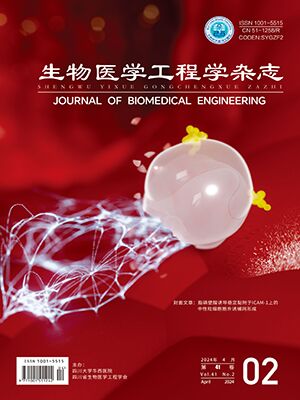| 1. |
An C, Cheng Z, Yu X, et al. Ultrasound-guided percutaneous microwave ablation of hepatocellular carcinoma in challenging locations: oncologic outcomes and advanced assistive technology. Int J Hyperther, 2020, 37(1): 89-100.
|
| 2. |
Izzo F, Granata V, Grassi R, et al. Radiofrequency ablation and microwave ablation in liver tumors: an update. Oncologist, 2019, 24(10): 1-16.
|
| 3. |
Perrodin S, Lachenmayer A, Maurer M, et al. Percutaneous stereotactic image-guided microwave ablation for malignant liver lesions. Sci Rep-UK, 2019, 9(1): 1-8.
|
| 4. |
Simon C J, Dupuy D E, Mayo-Smith W W. Microwave ablation: principles and applications. Radiographics, 2005, 25(S1): S69-S83.
|
| 5. |
高钦宗, 王志伟, 金征宇. 肝癌热消融治疗后影像学评价的进展. 医学研究杂志, 2018, 47(9): 10-14.
|
| 6. |
欧阳亚丽, 周著黄, 吴水才, 等. 超声零差K模型仿真研究. 北京生物医学工程, 2019, 38(2): 13-19.
|
| 7. |
Oelze M L, Mamou J. Review of quantitative ultrasound: envelope statistics and backscatter coefficient imaging and contributions to diagnostic ultrasound. IEEE Trans Ultrason Ferroelectr Freq Control, 2016, 63(2): 336-351.
|
| 8. |
Cristea A, Collier N, Franceschini E, et al. Quantitative assessment of media concentration using the Homodyned K distribution. Ultrasonics, 2020, 101: 105986.
|
| 9. |
Zhou Z, Wu S, Wang C Y, et al. Monitoring radiofrequency ablation using real-time ultrasound Nakagami imaging combined with frequency and temporal compounding techniques. PLoS ONE, 2015, 10(2): e0118030.
|
| 10. |
Zhang S, Shang S, Han Y, et al. Ex vivo and in vivo monitoring and characterization of thermal lesions by High-Intensity Focused Ultrasound and microwave ablation using ultrasonic Nakagami imaging. IEEE T Med Imaging, 2018, 37(7): 1701-1710.
|
| 11. |
Destrempes F, Cloutier G. A critical review and uniformized representation of statistical distributions modeling the ultrasound echo envelope. Ultrasound Med Biol, 2010, 36(7): 1037-1051.
|
| 12. |
Zhou Z, Zhang Q, Wu W, et al. Hepatic steatosis assessment using ultrasound homodyned-K parametric imaging: the effects of estimators. Quant Imaging Med Surg, 2019, 9(12): 1932-1947.
|
| 13. |
Byra M, Nowicki A, Wróblewska-Piotrzkowska H, et al. Classification of breast lesions using segmented quantitative ultrasound maps of homodyned K distribution parameters. Med Phys, 2016, 43(10): 5561-5569.
|
| 14. |
Zhou Z, Fang J, Cristea A, et al. Value of homodyned K distribution in ultrasound parametric imaging of hepatic steatosis: an animal study. Ultrasonics, 2020, 101: 106001.
|
| 15. |
Omura M, Yoshida K, Akita S, et al. Verification of echo amplitude envelope analysis method in skin tissues for quantitative follow-up of healing ulcers. Jpn J Appl Phys, 2018, 57(7S1): 07LF15.
|
| 16. |
Roy-Cardinal M H, Destrempes F, Soulez G, et al. Assessment of carotid artery plaque components with machine learning classification using homodyned-K parametric maps and elastograms. IEEE Trans Ultrason Ferroelectr Freq Control, 2018, 66(3): 493-504.
|
| 17. |
Hruska D P, Oelze M L. Improved parameter estimates based on the homodyned K distribution. IEEE Trans Ultrason Ferroelectr Freq Control, 2009, 56(11): 2471-2481.
|
| 18. |
Destrempes F, Porée J, Cloutier G. Estimation method of the homodyned K-distribution based on the mean intensity and two log-moments. SIAM J Imaging Sci, 2013, 6(3): 1499-1530.
|
| 19. |
Wang C Y, Geng X, Yeh T S, et al. Monitoring radiofrequency ablation with ultrasound Nakagami imaging. Med Phys, 2013, 40(7): 072901.
|
| 20. |
Jakeman E. On the statistics of K-distributed noise. J Phys A-Math Gen, 1980, 13(1): 31-48.
|
| 21. |
吴水才, 王月, 周著黄, 等. 基于超声组织定征技术的肿瘤热疗无创监测方法研究进展. 北京工业大学学报, 2017, 43(10): 1488-1496.
|
| 22. |
Tsui P H, Tsai Y W. Artifact reduction of ultrasound Nakagami imaging by combining multifocus image reconstruction and the noise-assisted correlation algorithm. Ultrasonic imaging, 2015, 37(1): 53-69.
|
| 23. |
Zhou Z, Wang Y, Song S, et al. Monitoring microwave ablation using ultrasound echo decorrelation imaging: an ex vivo study. Sensors, 2019, 19(4): 977.
|
| 24. |
Pohlman R M, Varghese T, Jiang J, et al. Comparison of displacement tracking algorithms for in vivo electrode displacement elastography. Ultrasound Med Biol, 2019, 45(1): 218-232.
|
| 25. |
Ingle A N, Varghese T. A kernel smoothing algorithm for ablation visualization in ultrasound elastography. Ultrasonics, 2019, 96: 267-275.
|
| 26. |
Su L, Tian W, Xu M, et al. Performance of shear wave elastography in delineating the radiofrequency ablation boundary: an in vivo experiment. Ultrasound Med Biol, 2019, 45(5): 1324-1330.
|
| 27. |
Zeng X, Zhang Y, Li Z, et al. Locations of optimally matched Gabor atoms from ultrasound RF echoes for inter-scatterer spacing estimation. Comput Meth Prog Bio, 2020, 184: 105281.
|
| 28. |
Zhang S, Xu R, Shang S, et al. In vivo monitoring of microwave ablation in a porcine model using ultrasonic differential attenuation coefficient intercept imaging. Int J Hyperther, 2018, 34(8): 1157-1170.
|
| 29. |
Zhang S, Wu S, Shang S, et al. Detection and monitoring of thermal lesions induced by microwave ablation using ultrasound imaging and convolutional neural networks. IEEE J Biomed Health, 2020, 24(4): 965-973.
|




